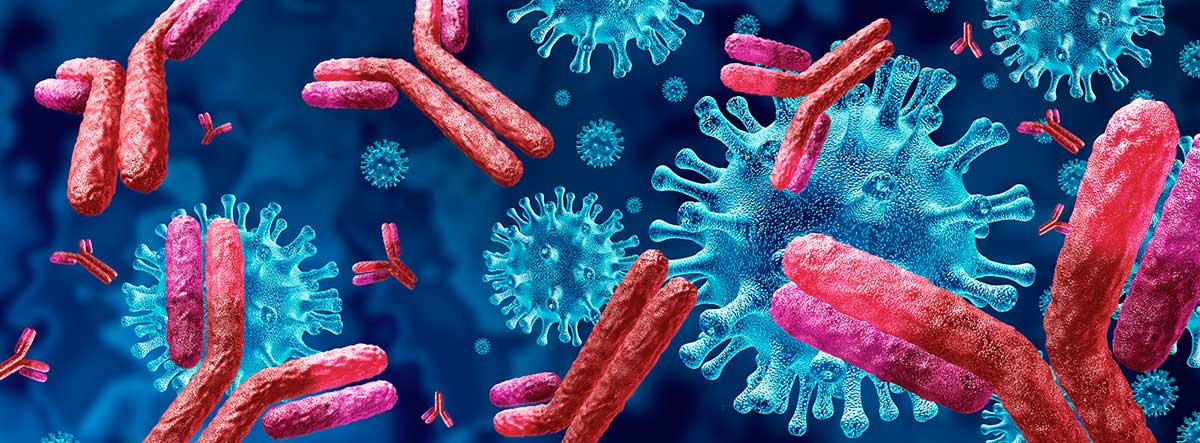The Science of Antibodies

Antibody technology that revolutionized human health is here for your calves.
Antibodies are uniquely powerful proteins that naturally occur in the body during an immune response. When molecules – also called antigens – from viruses and bacteria invade, the body produces antibodies to fight them.
Scientists in human health have developed antibody medicines that mimic naturally occurring antibodies. These are preformed antibodies, and they can take decades of research to bring to market. Scientists optimized these antibodies to target specific diseases. As a result, a greater number of antibodies can be present in the body to fight targeted disease without affecting other cells.
These preformed antibodies are Y-shaped. Think of the Y as two different arms that grab, or bind to, viruses and bacteria. We designed our antibody arms to bind to coronavirus, rotavirus, and E. coli bacteria. Our anti-viral and anti-bacterial preventative medicines grab hold of those pathogens, preventing pathogens from entering a cell and harming it. Directly, and rather immediately, preventing infection.
Antibody products versus vaccines
When a newborn calf is vaccinated for scours, it is receiving a small dose of the scours pathogens. Its body must do the work of stimulating antibody production to mount an immune response. The same goes for bred heifers and cows receiving a pre-calving vaccine designed to transfer specific anti-scour antibodies to calves via their colostrum.
The challenge with using a scours vaccine is you can’t determine if they indeed generated a protective immune response. Several factors can prevent immunization, such as animal stress and vaccine handling. Whether vaccinating the calf or using a pre-calving vaccine, vaccine-response variability regularly leaves 20 to 30 percent of calves unprotected.
Simply put, vaccination does not equal immunization.
An antibody product isn’t a vaccine. It is the end-game. It is literally the antibodies already preformed and guaranteed at a level proven to be protective in third-party studies. Calves given an antibody product receive protection directly. Immunization happens immediately without having to trigger an immune response. Because the antibodies are preformed and potency tested, you know the exact level of protection you are getting, and it’s consistent calf-to-calf. There’s no variability.
How we guarantee antibody levels
The colostrum from which our antibodies are purified comes from cows on a strict commercial scours vaccine program. In order to guarantee high levels of E. coli, coronavirus and rotavirus antibodies, these cows are also exposed to ImmuCell’s proprietary vaccine regimen.
Unlike a typical operation, if our donor cows calve early or late, if they miss a single shot within the regimen, or if timing of administration is off at all, we do not use their colostrum. That’s because the cows would not be at peak antibody levels and protection would be compromised.
Our antibodies are verified, veterinary biologics providing immediate, guaranteed levels of specific antibodies proven to protect against both bacterial and viral scours in newborn calves.
Passive versus active antibodies.
You may hear First Defense referred to as passive antibody protection. A passive antibody acts immediately. Vaccines provide active immunity, which means antibodies must develop in the animal. This step takes time and can tax the animal’s immune system.
Passive antibodies do the work for the dam or calf. The effect is immediate. The level of antibody protection is guaranteed.
Baylor research led to greater potency of rotavirus antibodies
The road to success in animal health pharmaceuticals is often long and involves collaboration with outside organizations. Our journey to develop rotavirus antibodies began with research conducted by the Mary K. Estes Lab at Baylor College of Medicine in Houston, Texas.
Mary Estes, Ph.D., is a Distinguished Service Professor at Baylor College of Medicine. Her work focuses on gastrointestinal infections, virus-host interactions and mechanisms of pathogenesis and immunity. Her research on rotavirus has worldwide impact.
Years after her lab began to investigate the structure and biology of rotavirus, her work generated not only a better understanding of viral proteins and capsid structure, but also resulted in a candidate virus-like particle vaccine. Estes Lab’s initial results were published in the Journal of Virology in 1994.
“We were not planning on developing a vaccine,” says Estes. However, she says, “Over a number of years, we determined the best immunization protocols, including the best route and use of different adjuvants, for virus-like particles to be highly immunogenic in a number of species. Our studies showed that these particles had clear potential as a vaccine for both humans and animals.”
Recognizing Baylor’s research, our parent company, ImmuCell, developed and field tested a vaccine of virus-like particles in cows. The cows responded by producing rotavirus antibodies in their colostrum at much higher rates than traditional vaccines. Field trials successfully showed the ability of preformed rotavirus antibodies generated through this virus-like particle vaccine to protect newborn calves from the virus, resulting in Tri-Shield First Defense, the first and only veterinary biologic proven to provide immunization against K99+ E. coli, coronavirus and rotavirus infections.
Dr. Donna Gatewood, EDGE Veterinary Vaccines Consulting Group LLC, describes what it means to have USDA approval.

The manufacturer of a USDA licensed product must demonstrate that the product performs the way that the claims on the label say it’s going to perform. This is unlike supplements or feed additives which only describe what the material is without any proof of performance. That’s according to Dr. Donna Gatewood, EDGE Veterinary Vaccines Consulting Group, LLC.
If a product says it’s to prevent a particular disease, the manufacturer is required to complete trials to show that the product will prevent or treat that disease. These trials have strict USDA oversight and need to meet high statistical standards – data cannot be cherry picked.
